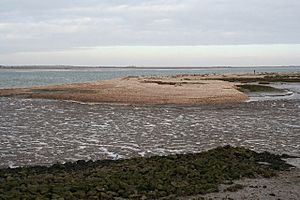South Swale facts for kids
Quick facts for kids South Swale |
|
|---|---|
 |
|
| Type | Local Nature Reserve |
| Location | Faversham, Kent |
| OS grid | TR 047 653 |
| Area | 410.5 hectares (1,014 acres) |
| Managed by | Kent Wildlife Trust |
South Swale is a fantastic natural area located north of Faversham in Kent, England. It is a very large Local Nature Reserve, covering about 410.5 hectares (1,014 acres). This means it is a special place set aside to protect wildlife and give people a chance to connect with nature.
The land at South Swale is owned by Kent County Council. It is looked after and managed by the Kent Wildlife Trust, a group dedicated to protecting wild places. South Swale is also part of an even bigger, super important natural area called The Swale. This larger area has special protections as a Ramsar site, a Special Protection Area, and a Site of Special Scientific Interest. These titles show just how important South Swale is for wildlife, especially birds and wetland habitats.
Contents
Discover South Swale's Amazing Wildlife
South Swale is a coastal area, which means it's right by the sea. It has different types of land, including wetlands and grasslands. Wetlands are areas where the land is often wet, like marshes or swamps. Grasslands are open areas covered in grass.
Birds of the Mudflats
One of the most important parts of South Swale is its mudflats. These are flat, muddy areas that are covered by water at high tide and exposed at low tide. Mudflats are like a giant buffet for birds! They are full of tiny creatures and plants that birds love to eat.
In winter, South Swale becomes a very busy place for birds. Huge numbers of wading birds and wildfowl come here. Wading birds are those with long legs, like curlews or redshanks, that walk through shallow water to find food. Wildfowl are birds like ducks, geese, and swans. They come to South Swale to feed and rest during the colder months.
Plants You Might See at South Swale
The reserve is not just great for birds; it also has a wonderful variety of plants. These plants are specially adapted to live in a coastal environment.
Some of the cool plants you might spot include:
- Yellow horned-poppies: These plants have bright yellow flowers and long, horn-shaped seed pods.
- Sea-lavender: Despite its name, this plant isn't a true lavender. It has beautiful purple flowers that grow in clusters.
- Golden samphires: These plants have fleshy leaves and yellow flowers. They often grow in salty marshy areas.
- Wild carrots: This is the wild version of the carrots we eat! It has delicate white flowers that grow in flat-topped clusters.
Exploring the Reserve: The Saxon Shore Way
If you love walking and exploring, South Swale is a great place to visit. A public footpath called the Saxon Shore Way runs right through the reserve.
This path follows the top of the sea wall for the entire length of the reserve. It goes around the village of Graveney. The walk is about 3 miles long in total. It offers amazing views of the mudflats, the sea, and the wildlife that calls South Swale home. It's a perfect way to experience the beauty of this special nature reserve.

